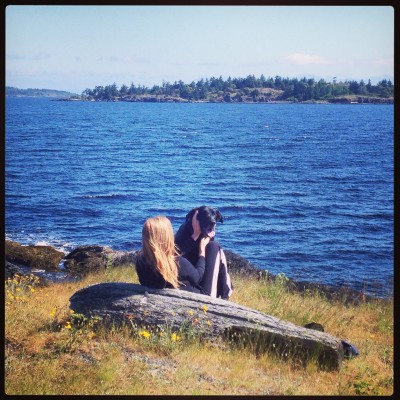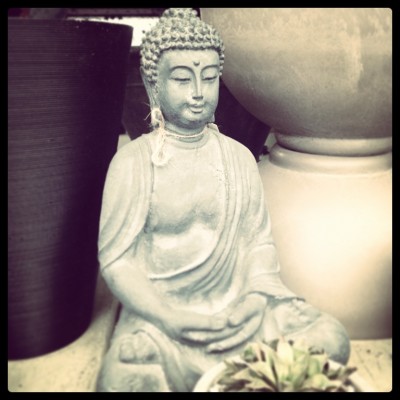Stillness
I believe there’s a misconception about what a daily meditation practice looks like. That it has to include specific rituals, or unfold a certain way in order to be of benefit. That it’s only an esoteric pursuit. But that’s just not so! Meditation is simple and for everyone.
Stillness is a much better word to describe what my daily practice looks like. Or should I say ‘cultivating stillness’, as attaining that desired quiet mind is never instant or simple. Stillness can be described as ‘just being’, without the interference of thoughts. The objective is to quiet your monkey brain long enough to create spaces between your thoughts. At first these gaps will be fleeting, but in time the spaces expand. It’s a process of finding your way back to the stillness, over and over and over. Meditating is like wrestling with puppies – chaos, punctuated by moments of bliss.
Where?
It’s rare that I sit cross-legged in lotus, with palms face up on my knees all Buddha-esque. More often I’m laying down on the floor (or the grass), or just sitting comfortably on the sofa (or on a log at the beach). I love to meditate outside. Weeding meditation is a seasonal practice (and you get something to show for it!), while walking the dog meditation is an all season fan favourite. Not to be overlooked are waiting in line meditation, stuck in traffic meditation, and ferry meditation. I love multi-tasking! My point being, not having the perfect time or the perfect space shouldn’t deter you from slipping in some quiet time.
How?
The goal is to quiet the chatter of your mind, to find prolonged moments of stillness and silent awareness. And you do this by choosing something to focus on. As your thoughts stray away from your focus and onto what you’re going to make for dinner or that phone call you need to return (and they will!) just gently return your awareness back to your focus. Over and over and over, without resistance or judgment on your performance. In time and with practice, you will spend less time herding your thoughts and more time in the silence between… which is where the magic is.
Start by focussing on your breath. You don’t need to exaggerate your breathing, but just centre your awareness on the subtle sound and feeling of the air entering and leaving your body.
If you need something more commanding to focus on then try repetition of words. I use mantras because these are what I was taught when I learned to meditate 20 years ago, and they are instantly calming.
Om Namah Shivaya (I bow to my true self)
Sat Chit Ananda (existence, consciousness, bliss)
So Hum (I am that)
Don’t force yourself to use any specific words if they don’t feel right for you. You can use everyday words with just as much effect. Try choosing one or two positive words that resonate for you and repeat them in time with your breath… Joy, Love, Peace, Bliss, Happiness. It can be very useful if you’re struggling with a particular problem in your life, to choose words that affirm a positive outcome…. Forgiveness, Acceptance, Health, Abundance.
Guided meditations are useful for relaxation, but I find that as I’m picturing myself on that warm sandy beach, my imagination takes over and moves me away from the silence and into my thoughts. However, having peaceful music playing quietly in the background can be helpful.
I do enjoy the Deepak Chopra meditation series. He starts the 15 minutes with a brief lesson, then introduces a mantra, rings a bell, and then you get a period of silence with soft music playing. Your meditation ends with another bell, and he sends you into your day with a centering thought. This is a great place for beginners to start.
How long?
As long as you want! Start out with shorter, more manageable times and work your way up as you get more comfortable. As little as 5 minutes can be beneficial. I often meditate multiple times per day, because I don’t wait to find the perfect time or place. My morning meditation is the longest – I find 20-30 minutes is about right. It takes a bit of time to find my rhythm, settle into the stillness.
Why?
When you become the observer of your thoughts, rather than identifying with them, you development an awareness of your true self. That deeply peaceful, silent being that is able to witness the chatter of the monkey brain is your true nature. When settled in that place of silent awareness, I am able to be more present to messages from the subconscious. It’s particularly helpful if you’re trying to make a tough decision, or if you are looking for answers for important life questions. You will be amazed at the information you receive from your true self in these moments of quiet.
Stillness is a safe harbour. As you become more practiced at releasing thoughts and centering yourself, you realize that you have this place to retreat to whenever you need. Any time, any place. You have the ability to step away from any situation that’s troubling you, settle your mind, then return with a fresh perspective. Stillness melts anger, calms fear, soothes emotions.
Meditation brings you into the Here & Now. It’s curious how we spend the majority of our time thinking about things that happened in the past, or things that are (potentially) going to happen in the future. The moment that really counts and deserves our attention is the one we are presently in. Now, and now, and now. Just Be Here Now!
At the end of meditation, when my mind is very clear, empty of thought and I’m settled into the present, I like to finish by spending a few minutes visualizing my goals and dreams. The present moment, devoid of distracting thoughts, is supremely fertile ground. Sow the seeds of your intentions and desires, let the universe know what you want in your life. Be very specific and paint a picture in your mind of your vision. Feel what it’s like to be living it.
Namaste
~kristi
© Kristi Bellis and Bluleaf Living, 2014. Unauthorized use and/or duplication of this material without express and written permission from this blog’s author and/or owner is strictly prohibited. Excerpts and links may be used, provided that full and clear credit is given to Kristi Bellis and Bluleaf Living with appropriate and specific direction to the original content.

